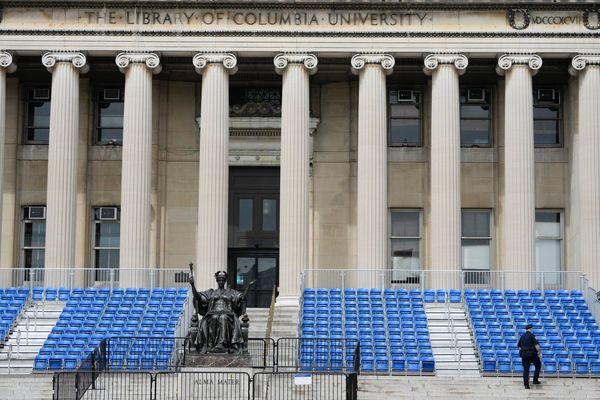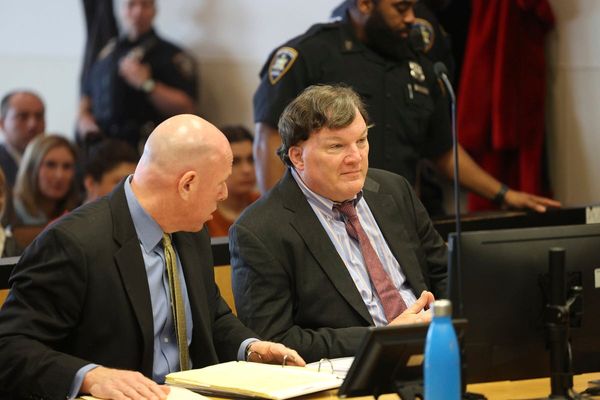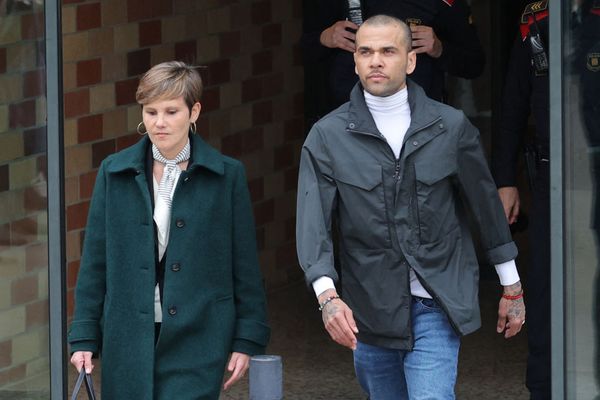
Step inside the rave. To your left is euphoria: topless dancers lost in the moment. Straight ahead is the chillout zone: your friends draped over each other, their bodies exuding electric jolts of red, yellow and blue under the lights. But it’s to your left that the real wildness is taking place: a blur of bodies in the dark, with dangling penises, parted buttocks and gaping mouths gradually emerging into focus.
The only thing missing from this room full of hedonism is the music, for this nightclub is not a nightclub at all. Rather, it’s Night, an exhibition of lifesize paintings by Israeli-born artist Doron Langberg. They unashamedly chart the pleasures of various nights out in queer spaces, from the dancing and sex to the blissful beach comedowns. It was a subject Langberg was initially uncertain about tackling.
“There was something in me that felt, ‘Oh, this can’t be the subject of a show,’” says the 38-year-old as he walks me around the gallery. “It’s too frivolous. There’s too much fun and desire.” Langberg’s previous works have included landscapes, still lifes and portraits of his friends and lovers – things he feels everyone could relate to. “Whereas these are experiences that not everybody has … not many people outside of this community have access to these spaces.”
Still, lots of people have formative moments in clubs, and who wouldn’t be at least intrigued by a painting like Dark Room (Underwear Party), which offers a birds-eye view (“almost an out of body experience”) of naked bodies tangled together in one smudged, swirling, orgiastic mass?
“A lot of that one was painted with my hands,” says Langberg. He likes to connect with the sensuality of paint: the way it feels to slap it on, or stroke it across, the canvas. “I almost wanted to re-create that feeling of going through that swarm of people, where everybody’s touching you and you’re touching everybody else.”

Langberg grew up in Yokneam Moshava, a small, agricultural settlement in Israel, producing his first oil painting – of Ariel from The Little Mermaid – aged just six. His father was a maths professor and his mother a teacher of psychology and child development, but they lived surrounded by farming neighbours. “It was very quiet: we were by the mountains and it was green and beautiful and we’d go hiking.”
He did his national service, working as an aeroplane mechanic, before heading to study art at the Pennsylvania Academy of the Fine Arts and then Yale. As an undergrad, Langberg was drawn to painting sexual scenes, although he was unsure why at the time. “People want to know why, like it has to be justified,” he says. “But I was in my early 20s when I made those works. And I think, at the time, queerness was sex.” He’s since wanted to extend the boundaries of what queerness can mean. “Just growing as a person, I wanted my work to describe different kinds of experiences.”
Langberg has talked before about bringing a queer perspective to paintings such as a landscape, or a picture of his brothers hiking. How does he do this? It was a question he once struggled to answer until a studio mate pointed out: “why would a landscape be straight? Like, why should it be incumbent on me, as a queer person, to have to make it queer, the assumption being that it’s not?” He laughs: “So it’s not like ‘this bit of paint is gay’. But there’s maybe a set of experiences that structure our way of being in the world. And through that you can look at different things.”
After he graduated, Langberg’s paintings broadened into depicting tender scenes of lovers, friends and siblings. Such works have led to him being labelled as part of a group called the New Queer Intimists – a collection of young artists including Louis Fratino and Salman Toor who build on the ideas of the original intimists Pierre Bonnard and Édouard Vuillard. With a pandemic still in recent memory and our reliance on digital communications reducing the need for face-to-face contact, the time feels right for paintings that can make us feel a human connection. “When I graduated, it was all about process-based abstraction,” says Langberg. “If you talked about intimacy or anything remotely emotional, it would be so uncool. Now there’s more of a willingness to see these connections as being valuable for art making.”

We head upstairs for the afterparty: paintings that depict the night melting away post-club. Perhaps the most striking is The Walk Back (Underwear Party), which depicts two figures wandering home from a party on New York’s Fire Island. Is it supposed to be joyful? Because with its murky greens, browns and blacks, it looks more to me like something Paul Nash might have conjured up, two figures traversing desolate trenches.
Langberg is intrigued by my reaction. He then tells me the painting took four months because he was struggling to depict “the middle of nature at night, with no artificial light … I had to paint it over and over again before I was happy with it. And this was all taking place while the war [in Gaza] was going on. My brothers saw what I was working on and commented how the outside world was creeping into my work.” The conflict, he says, has been “heartbreaking” and “intolerable to watch”.
The next painting, of a friend recovering on a sofa as the sun rises, comes almost as a relief – a burst of light and colour, more akin to Langberg’s previous works. “When people are gazing into space, or napping … that’s when they are most themselves,” says Langberg. “That’s when I’m able to access the most of my subject.”
And then the party is, sadly, over: those great moments of transcendence now just a memory. Or are they? “I think paintings themselves can be transcendent experiences,” notes Langberg before I leave. “That we can look at something from a different time, a different context, and experience what the painter is depicting really vividly. It’s interesting for those two things to meet.”
• Doron Langberg: Night is at Victoria Miro, London, until 28 March
• This article was amended on 7 February 2024. Doron Langberg is 38, not 39.







